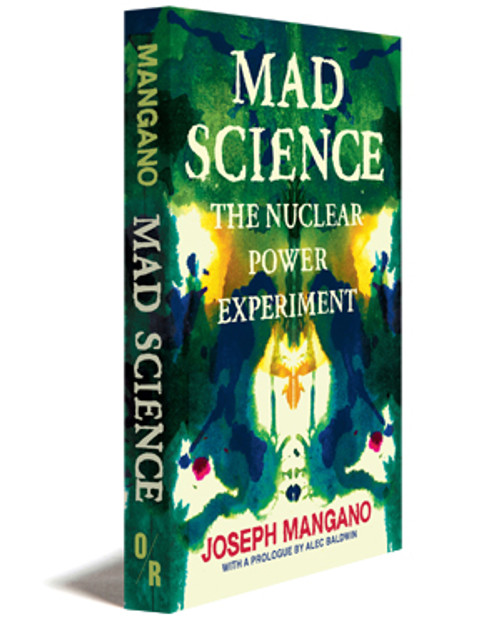Mad Science
about the bookabout
Will Americans once again play nuclear roulette?
Just one year after the Fukushima meltdown, all 54 reactors in Japan have been closed, and may never be restarted. Germany recently closed several reactors, and will shutter them all within a decade. Italy revoked its pledge to build new reactors, keeping that nation nuclear-free. All these decisions are based on the understanding that reactors are extremely dangerous and expensive.
In the U.S., the remnants of the once-overwhelmingly powerful nuclear lobby are making their last stand for "clean" nuclear energy. The sixty-year-old vision of power "too cheap to meter" (words originally uttered by a banker promoting the industry) is back. While other countries end their reliance on nuclear energy, Americans contemplate its revival, even as existing reactors, which produce a fifth of U.S. electricity, pass retirement age and are corroding.
In Mad Science, Joseph Mangano strips away the near-smothering layers of distortions and outright lies that permeate the massive propaganda campaigns on behalf of nuclear energy. He explores the history of the industry, with its origins in the Manhattan Project, through its heightening promotion during the Cold War and its entwinement with nuclear weapons.
Mad Science includes an account of nuclear accidents and meltdowns and their consequences, from Chernobyl to Santa Susana and beyond; as well as a point-by-point refutation of pro-nuke arguments. Atomic energy is unsafe - it deals with staggeringly poisonous substances at every stage of its creation – un-economical in the extreme and impractical.
"Joe Mangano is the constant, tireless voice that has helped keep me linked to reports from the front lines of the battle to expose the staggering risks to public health posed by nuclear power...Joe has been one of the most dedicated, intelligent and even-handed public activists I have ever known. He has also proven to be one of the most effective, on a battlefield where gains are measured in inches, if not centimeters." - from the foreword by Alec Baldwin
About The Author / Editor
Preview
On a warm California morning - July 12, 1959 – just outside Los Angeles, workers at the experimental nuclear reactors at the Santa Susana Field Laboratory reported for duty. Those who worked on the Sodium Reactor Experiment, one of ten reactors at the lab, were eager to make the fourteenth in a series of tests of the futuristic machine. The experiment tried to cool uranium fuel in the reactor core with sodium rather than the standard method, which used water. Hopes were high that this design would revolutionize atomic power reactors in the US, and perhaps around the world.
There had been problems with the first thirteen tests over the past two years. In the most recent one, there had been an explosion. The inexperienced workers tried to find its cause, but were unsuccessful. In retrospect, leaks had probably limited the ability to keep the sodium cool – a crucial aspect of running the reactor safely. But instead of taking the prudent path of stopping or postponing the test series, Test 14 was placed right on schedule, with no delays.
Almost immediately after work began, something went badly wrong. The sodium was not cooling the reactor core, which heated up to levels never seen before at Santa Susana – or perhaps in the US. Inside the core were long rods, containing uranium atoms that were split to power the reactor, along with the dozens of dangerous radioactive chemicals formed as waste products when uranium atoms are split. The long rods began to melt, and a large volume of radioactive gas built up in the reactor room. Instead of shutting down the reactor and investigating the cause, technicians added additional rods designed to control the process, but these only made the situation worse.
The next two weeks were a series of re-starts and more melting down, similar to repeatedly banging one's head against a brick wall. Why didn't managers shutdown the Sodium Reactor Experiment? The answer was one common to the US atomic power program; adherence to a mentality of "the show must go on" in spite of any dangers. Every day, radioactive gases from holding tanks in the reactor building were released into the air – often at night, a highly toxic job given to workers on the "graveyard shift". Finally, two weeks to the day after the run started, the reactor was finally shut down. The amount of radiation released into the environment was never accurately measured – in fact the entire meltdown was kept secret from the public for the next two decades. Sodium cooled reactors failed; of the 439 reactors operating worldwide today, only two are sodium cooled (none in the US). But the damage had been done, and today the Santa Susana site sits amidst a large mess of toxic waste.
in the media
Mad Science
about the bookabout
Will Americans once again play nuclear roulette?
Just one year after the Fukushima meltdown, all 54 reactors in Japan have been closed, and may never be restarted. Germany recently closed several reactors, and will shutter them all within a decade. Italy revoked its pledge to build new reactors, keeping that nation nuclear-free. All these decisions are based on the understanding that reactors are extremely dangerous and expensive.
In the U.S., the remnants of the once-overwhelmingly powerful nuclear lobby are making their last stand for "clean" nuclear energy. The sixty-year-old vision of power "too cheap to meter" (words originally uttered by a banker promoting the industry) is back. While other countries end their reliance on nuclear energy, Americans contemplate its revival, even as existing reactors, which produce a fifth of U.S. electricity, pass retirement age and are corroding.
In Mad Science, Joseph Mangano strips away the near-smothering layers of distortions and outright lies that permeate the massive propaganda campaigns on behalf of nuclear energy. He explores the history of the industry, with its origins in the Manhattan Project, through its heightening promotion during the Cold War and its entwinement with nuclear weapons.
Mad Science includes an account of nuclear accidents and meltdowns and their consequences, from Chernobyl to Santa Susana and beyond; as well as a point-by-point refutation of pro-nuke arguments. Atomic energy is unsafe - it deals with staggeringly poisonous substances at every stage of its creation – un-economical in the extreme and impractical.
"Joe Mangano is the constant, tireless voice that has helped keep me linked to reports from the front lines of the battle to expose the staggering risks to public health posed by nuclear power...Joe has been one of the most dedicated, intelligent and even-handed public activists I have ever known. He has also proven to be one of the most effective, on a battlefield where gains are measured in inches, if not centimeters." - from the foreword by Alec Baldwin
About The Author / Editor
Preview
On a warm California morning - July 12, 1959 – just outside Los Angeles, workers at the experimental nuclear reactors at the Santa Susana Field Laboratory reported for duty. Those who worked on the Sodium Reactor Experiment, one of ten reactors at the lab, were eager to make the fourteenth in a series of tests of the futuristic machine. The experiment tried to cool uranium fuel in the reactor core with sodium rather than the standard method, which used water. Hopes were high that this design would revolutionize atomic power reactors in the US, and perhaps around the world.
There had been problems with the first thirteen tests over the past two years. In the most recent one, there had been an explosion. The inexperienced workers tried to find its cause, but were unsuccessful. In retrospect, leaks had probably limited the ability to keep the sodium cool – a crucial aspect of running the reactor safely. But instead of taking the prudent path of stopping or postponing the test series, Test 14 was placed right on schedule, with no delays.
Almost immediately after work began, something went badly wrong. The sodium was not cooling the reactor core, which heated up to levels never seen before at Santa Susana – or perhaps in the US. Inside the core were long rods, containing uranium atoms that were split to power the reactor, along with the dozens of dangerous radioactive chemicals formed as waste products when uranium atoms are split. The long rods began to melt, and a large volume of radioactive gas built up in the reactor room. Instead of shutting down the reactor and investigating the cause, technicians added additional rods designed to control the process, but these only made the situation worse.
The next two weeks were a series of re-starts and more melting down, similar to repeatedly banging one's head against a brick wall. Why didn't managers shutdown the Sodium Reactor Experiment? The answer was one common to the US atomic power program; adherence to a mentality of "the show must go on" in spite of any dangers. Every day, radioactive gases from holding tanks in the reactor building were released into the air – often at night, a highly toxic job given to workers on the "graveyard shift". Finally, two weeks to the day after the run started, the reactor was finally shut down. The amount of radiation released into the environment was never accurately measured – in fact the entire meltdown was kept secret from the public for the next two decades. Sodium cooled reactors failed; of the 439 reactors operating worldwide today, only two are sodium cooled (none in the US). But the damage had been done, and today the Santa Susana site sits amidst a large mess of toxic waste.







